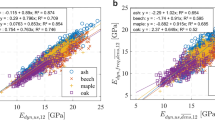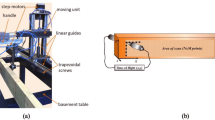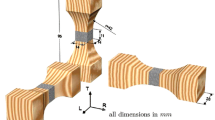Abstract
Air-coupled ultrasound and electrical impedance spectroscopy are non-destructive measurement methods, which can be used, for example for quality assessment of sawn timber. Both methods may be used in through-transmission and one-sided reflection mode to measure internal properties and detect defects in wood materials. The ultrasound method is based on mechanical waves and is mainly affected by the mechanical properties of wood. Density affects both methods, and the electrical impedance method is especially affected by moisture content and the chemical properties of wood. In this study, the relations between the methods and the bending properties of air dried and modified aspen (Populus tremula L.) specimens were examined. The modification method was a combination of compression and thermal modification. According to the study, electrical impedance spectroscopy combined with air-coupled ultrasound measured across the grain is a potential non-destructive technique for the strength estimation of aspen wood.






Similar content being viewed by others
References
Bhardwaj MC (2004a) Evolution of piezoelectric transducers to full scale non-contact ultrasonic analysis mode. In: Proceedings of 16th World Conference on Nondestructive Testing, August 30th–September 3rd, Montreal, Canada
Bhardwaj MC (2004b) High efficiency non-contact transducers and a very high coupling piezoelectric composite. In: Proceedings of 16th World Conference on Nondestructive Testing, August 30th–September 3rd, Montreal, Canada
Bodig J, Jayne BA (1982) Mechanics of wood and wood composites. Van Nostrand Reinhold, New York
Boonstra MJ, Van Acker J, Tjeerdsma BF, Kegel EV (2007) Strength properties of thermally modified softwoods and its relation to polymeric structural wood constituents. Ann For Sci 64(7):679–690
Brännström M (2009) Integrated strength grading. Dissertation, Luleå University of Technology, Skellefteå, Sweden
Bucur V (2010) Delamination detection in wood–based composites, a methodological review. In: Burgess M, Davey J, Don C, McMinn T (eds) Proceedings of 20th International Congress on Acoustics, ICA, August 23rd–27th, Sydney, Australia, pp 23–27
Bucur V (2011) Delamination in wood, wood products and wood-based composites. Springer, Dordrecht
Esteves BM, Pereira HM (2009) Wood modification by heat treatment: a review. Bioresources 4(1):370–404
Gan TH, Hutchins DA, Green RJ, Andrews MK, Harris PD (2005) Noncontact, high-resolution ultrasonic imaging of wood samples using coded chirp waveforms. IEEE T Ultrason Ferr 52(2):280–288
Hanhijärvi A, Ranta-Maunus A (2008) Development of strength grading of timber using combined measurement techniques. Report of the Combigrade Project-Phase 2. VTT Publications 686, VTT, Espoo
Heräjärvi H (2009) Effect of drying technology on aspen wood properties. Silva Fenn 43(3):433–445
Hilbers U, Thoemen H, Hasener J, Fruehwald A (2012) Effects of panel density and particle type on the ultrasonic transmission through wood-based panels. Wood Sci Technol 46(4):685–698
ISO 3133 (1975) Determination of ultimate strength in static bending. ICS 79.040, ISO/TC 218
ISO 3349 (1976) Broadleaved wood raw parquet blocks—classification of beech parquet blocks. ICS 79.040, ISO/TC 218
Junkkonen R, Heräjärvi H (2006) Physical properties of European and hybrid aspen wood after three different drying treatments. In: Kurjatko S, Kudela J, Lagana R (eds) Proceedings of the 5th International Symposium Wood Structure and Properties’06, September 3–6, 2006, Sliač–Sielnica. Arbora Publishers, Slovakia, pp 257–263
Kamdem DP, Pizzi A, Jermannaud A (2002) Durability of heat-treated wood. Holz Roh Werkst 60:1–6
Marchetti B, Munaretto R, Revel G, Tomasini EP, Bianche VB (2004) Non-contact ultrasonic sensor for density measurement and defect detection on wood. 16th World Conference on Nondestructive Testing, Montreal, Canada, August 30th–September 3rd
Möttönen V, Marttila J, Heräjärvi H (2014a) Impact of compression and thermal modification on mechanical properties of silver birch and European aspen wood. In: Parrotta JA, Moser CF, Scherzer AJ, Koerth NE, Lederle DE (eds.) Sustaining forests, sustaining people: The role of research. XXIV IUFRO World Congress, 5–11 October 2014, Salt Lake City, UT. Abstracts. Commonwealth Forestry Association, Int For Rev 16(5):444
Möttönen V, Marttila J, Heräjärvi H, Luostarinen K (2014b) Density profile and set-recovery of sawn wood after industrial scale THM processing. In proceedings: Processing Technologies for the Forest and Biobased Products Industries PTF BPI 2014 at the Salzburg University of Applied Sciences Kuchl/Austria, pp. 601–607
Möttönen V, Bütün Y, Heräjärvi H, Marttila J, Kaksonen H (2015) Effect of combined compression and thermal modification on mechanical performance of Aspen And Birch Wood. Pro Ligno 11(4):310–317
Niemz P, Mannes D (2012) Non-destructive testing of wood and wood-based materials. J Cult Herit 13(3):26–34
Pellerin RF, Ross RJ (2002) Nondestructive evaluation of wood. Forest Products Society, Madison
Ranta-Maunus A, Denzler JK, Stapel P (2011) Strength of European timber—Part 2. Properties of spruce and pine tested in Gradewood project. VTT Working papers 179, VTT, Espoo
Sanabria S (2012) Air-coupled ultrasound propagation and novel non-destructive bonding quality assessment of timber composites. Dissertation, ETH No 20404. Swiss Federal Institute of Technology Zürich, Switzerland
Sanabria SJ, Furrer R, Neuenschwander J, Niemz P, Sennhauser U (2011) Air-coupled ultrasound inspection of glued laminated timber. Holzforschung 65(3):377–387
Sanabria SJ, Furrer R, Neuenschwander J, Niemz P, Sennhauser U (2013a) Novel slanted incidence air-coupled ultrasound method for delamination assessment in individual bonding planes of structural multi-layered glued timber laminates. Ultrasonics 53(7):1309–1324
Sanabria SJ, Hilbers U, Neuenschwander J, Niemz P, Sennhauser U, Thömen H, Wenker JL (2013b) Modeling and prediction of density distribution and microstructure in particleboards from acoustic properties by correlation of non-contact high-resolution pulsed air-coupled ultrasound and X-ray images. Ultrasonics 53(1):157–170
Sanabria SJ, Furrer R, Neuenschwander J, Niemz P, Schütz P (2015) Analytical modeling, finite-difference simulation and experimental validation of air-coupled ultrasound beam refraction and damping through timber laminates, with application to non-destructive testing. Ultrasonics 63:65–85
Sandberg D, Navi P (2007) Introduction to thermo-hydro-mechanical (THM) wood processing. School of Technology and Design, Reports No. 30. Växjö University, Sweden
Saranpää P, Strömberg M (2004) Haavan ja hybridihaavan kuituominaisuudet (Fibre properties of Populus tremula L. and Populus tremula x tremuloides). Metsätieteen aikakauskirja 1/2004. pp. 76–78 (in Finnish)
Sebera V, Kotlinova M, Tippner J, Kloiber M (2010) Numerical simulation of elastic wave propagation in wood with defined tree rings. Wood Res 55 (3):1–12
Skaar C (1988) Wood-water relations. Springer Verlag, Berlin
Tiitta M, Olkkonen H (2002) Electrical impedance spectroscopy device for measurement of moisture gradients in wood. Rev Sci Instrum 73(8):3093–3100
Tiitta M, Savolainen T, Olkkonen H, Kanko T (1999) Wood moisture gradient analysis by electrical impedance spectroscopy. Holzforschung 53(1):68–76
Tomppo L, Tiitta M, Laakso T, Harju A, Venäläinen M, Lappalainen R (2011) Study of stilbene and resin acid content of Scots pine heartwood by electrical impedance spectroscopy (EIS). Holzforschung 65(5):643–649
Tomppo L, Tiitta M, Lappalainen R (2014) Non-destructive evaluation of checking in thermally modified timber. Wood Sci Technol 48(2):227–238
Tomppo L, Tiitta M, Lappalainen R (2016) Air-coupled ultrasound and electrical impedance analyses of normally dried and thermally modified Scots pine (Pinus sylvestris). Wood Mater Sci Eng 11(5):274–282
Torgovnikov GI (1993) Dielectric properties of wood and wood-based materials. Springer-Verlag, Berlin
van der Beek J, Tiitta M, Tomppo L, Lappalainen R (2011) Moisture content determination of thermally modified timber by electrical and ultrasound methods. Int Wood Prod J 2(2):60–66
Vun RY, Bhardwaj MC (2004) Non-contact ultrasonic characterization of in-plane density variation in oriented strandboard. 16th World Conference on Nondestructive Testing, Montreal, Canada, August 30th–September 3rd
Vun RY, Hoover K, Janowiak J, Bhardwaj M (2008) Calibration of non-contact ultrasound as an online sensor for wood characterization: Effects of temperature, moisture, and scanning direction. Appl Phys A 90(1):191–196
Welzbacher CR, Wehsener J, Haller P, Rapp AO (2006). Biologische und mechanische Eigenschaften von verdichteter und thermisch behandelter Fichte (Picea abies) (Biological and mechanical properties of densified and thermally treated spruce (Picea abies)) (in German). Holztechnologie 3:13–18
Widmann R, Fernandez-Cabo JL, Steiger R (2012) Mechanical properties of thermally modified beech timber for structural purposes. Eur J Wood Prod 76(6):775–784
Zelinka SL, Stone DR, Rammer DS (2007) Equivalent circuit modeling of wood at 12% moisture content. Wood Fiber Sci 39(4):556–565
Zelinka SL, Rammer DR, Stone DS (2008) Impedance spectroscopy and circuit modeling of southern pine above 20 % moisture content. Holzforschung 62(6):737–744
Acknowledgements
This study was financially supported by ERDF (EU) and Centre for Economic Development, Transport and the Environment (North Savo, project S12261), The Vocational Training Association of Woodworking Men, and Korwensuun Konetehdas Ltd. which also performed the modification treatments.
Author information
Authors and Affiliations
Corresponding author
Rights and permissions
About this article
Cite this article
Tiitta, M., Tomppo, L., Möttönen, V. et al. Predicting the bending properties of air dried and modified Populus tremula L. wood using combined air-coupled ultrasound and electrical impedance spectroscopy. Eur. J. Wood Prod. 75, 701–709 (2017). https://doi.org/10.1007/s00107-016-1140-0
Received:
Published:
Issue Date:
DOI: https://doi.org/10.1007/s00107-016-1140-0




